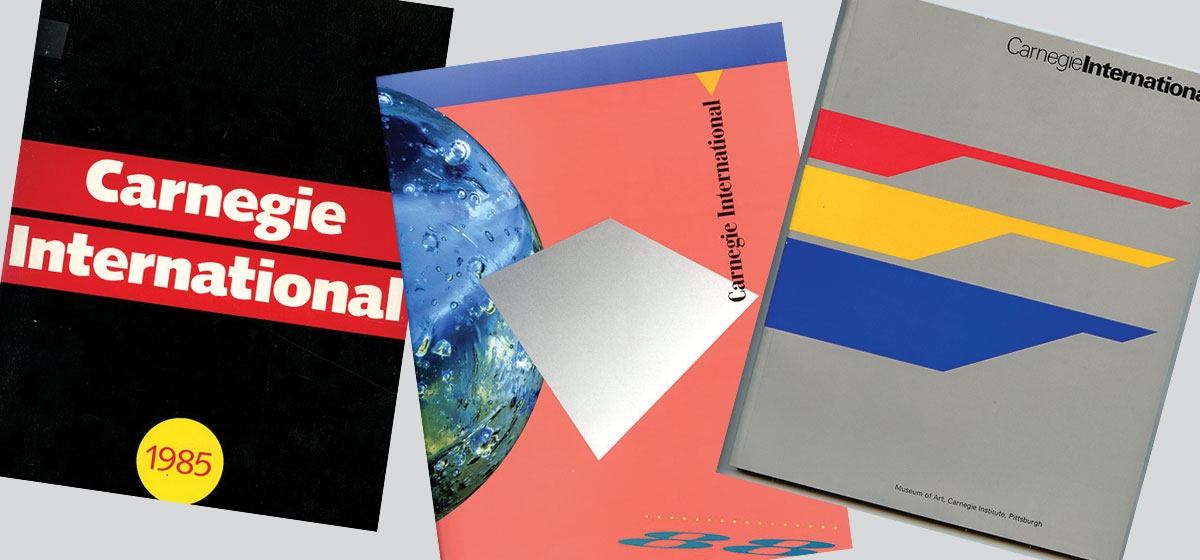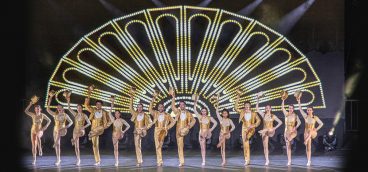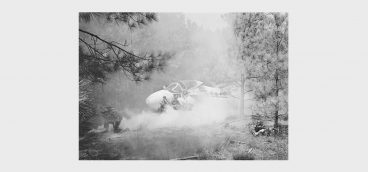
When the Carnegie International opens this fall, it may appear as if the world’s latest art elegantly touches down like an ethereal being whose time to visit us has come ‘round again. But if you knew it as I do, you would know that this periodic being is full of, shall we say, blemishes and peculiarities.
Sometimes simply getting the work here is the most difficult part. Padded canvases by Gotthard Graubner (1982) and Doris Salcedo’s furniture encased in cement (1995) were held up by overzealous drug enforcement at customs. In 1988, Sigmar Polke barred the door of his studio to the shippers who were frantically trying to get his work to Pittsburgh before the curtain rose. Why? Because he was still drying his paintings with a hairdryer.
Artists, of course, are by their natures challengers and challenging, and that ranges from the ordinary, everyday variety—such as one passing out on the lawn of WQED—to the more bizarre. For the International in 2005, Maurizio Cattelan, the enfant terrible of the art world, had created something just slightly less controversial than his kneeling (and perhaps praying) Hitler. Cattelan sculpted a barefoot JFK in his coffin, and he wanted to place it in the Hall of Architecture. The likeness of the dead president surrounded by plaster casts would have been a sight, but because of the annual women’s committee’s Christmas tree display and party, the barefoot JFK lay in waiting in the founder’s room, which was only periodically open.
But artists aren’t always the difficult ones. A Vija Celmins’ skyscape upset a night guard so much that he slashed it, requiring expensive conservation work.
And sometimes there are just weird vagaries that pop up—or down, as happened with the original drawing on the staircase up to the galleries by Sol LeWitt that came crashing down at the end of a weekend. Thankfully LeWitt liked it so much, he gave the museum a new drawing so it could go all the way up the stairs. Then there was Mark Dion, known for his interest in science and research, who planned to build a pseudo lab in the decorative arts galleries. Unfortunately the wood he sent was infested with insects. So it had to be constructed in the museum’s parking lot, dissembled, fumigated, and then reconstructed in the galleries. That’s a surefire way to break the budget and mess up the schedule.
With exhibitions like the International, the unexpected always happens. To visitors, everything appears magically in the galleries. The reality, however, can be quite different, and the stress and tension levels increase exponentially as opening day nears. By the time the galleries open, the staff is generally so tired, they just want to stay home.
Standing at attention
Francesco Clemente was important in the 1980s revival of painting, about a decade after many declared painting was dead. He was among a large group of neo-expressionists in the 1985 show and was included again in the 1988 version, represented that year by only one memorable work. Dreaming the Dreamers was more than 15 feet wide and it featured a supine nude with a notable erection. Clemente also included three couples, looking like flat, paper cutouts, engaged in sexual activity while wielding long poles topped with gloves, each with a finger pointing at the prominent organ. Even in the late ’80s, images like that could be considered unseemly. Moving to prevent problems, director Jack Lane paraded most of the trustees through the office hallway, called carpet corridor by the staff, to see the work and thwart any unwanted surprise reactions. As far as I know, no one complained.
Critics: From sublime to ridiculous
Throughout the years, everyone from critics and cartoonists to the general public have loved to weigh in on the International. In the earlier years, press coverage was extensive with serious critical debate about the art and the artists. In 1982, the museum wanted to initiate a meaningful discussion so we invited prominent national critics for a forum on the opening weekend. Chaired by the eminent Hilton Kramer, it was a “blistering critique,” in the words of Kay Larson. After comments called the show “a disappointment” and “a bad show,” New York Times critic Roberta Smith summed it up by saying that she “basically found nothing in this show that I would ever want to see again.” The local press sensationalized our response, by characterizing (falsely) the forlorn and sad looks on the faces of director Jack Lane and his wife. In reality, Lane did his due diligence and visited a large number of curators and directors in the U.S. and Europe in order to canvass opinions with the result a critical success in 1985.
At a dinner party for another exhibition that opened after the International, the namesake for the Purnell Center at CMU told me he thought that Lane should fire the entire staff and start over. Many Pittsburghers found the 1988 show entirely too depressing while others felt the 1991 iteration was overly intellectual and esoteric. One viewer responded to what he felt was self-serving mental masturbation by depositing some of himself in a sock and mailing it in a sealed plastic baggy to the museum.
Women take a stand
The history of the almost 60 versions of the show has been decidedly male dominated as well as Euro/American centric. Carnegie wanted to prove that American art was equal to European art, and in fact, the show wasn’t called an international until 1920 when it resumed after a pause during World War I. What would become the International was founded in 1896 when American patriarchal power and patriotism were practically unquestioned. That same year John Phillip Sousa wrote “Stars and Stripes Forever,” and the show reflected traditional and conservative values. As values changed, especially with the civil rights and women’s movements and the Vietnam war in the 1960s, the show’s very existence was questioned, but the ratio of men to women artists wasn’t. Even by the ’80s, the numbers were out of sync, and the Guerilla Girls, an anonymous group of women artists/activists, formed in New York City in 1985 as “the conscience of the art world,” gathering and disseminating statistics, mostly in the form of humorous, but hard-hitting posters and handouts. As far as I know, their posters showed up only once in the museum, albeit in obscure places.
The only serious protest occurred in 1988, when professors Elaine King of CMU and Ann Sutherland Harris of Pitt organized a women’s show. King was a close friend of curator John Caldwell and thus had advance notice about the artist list and used her inside information as the impetus to curate her show.
Perception and reality were often at odds; at the press conference announcing the artists for the 1991 show, director Phillip Johnston told me there were more women than ever when the numbers were exactly the same. And around the same time, he and I were talking about the final two candidates for curator of contemporary art and the International; he told me that the trustees weren’t ready to hire a woman for the job.
The increase in numbers of women in the show came in 1988, but not without a struggle. At a meeting of the advisory committee in Pittsburgh, curator John Caldwell started to discuss artists to be considered for inclusion. The committee had three men and three women, but Americans Kathy Halbreich and Joan Simon kept returning to women, forcing the issue. Caldwell always argued for the objective eye, but he had to face strong voices that stood up to him, arguing against discrimination. As a result, that show ended up including Anna Blume (with her husband Bernhard), Katharina Fritsch, Rebecca Horn, Sherrie Levine, Agnes Martin, Elizabeth Murray, Susan Rothenberg, Susanna Solano and Rosemarie Trockel.
A seismic change didn’t take place until this year, 2018. A female curator led the charge, and for the first time ever, in the almost 125 years of the show, there are more women than men in the exhibition. Going even further to be conversant with current issues, curator Ingrid Schaffner listed artists who self-identify as she or he, avoiding the traditional label of woman artist.
Catalog politics
The catalog lives on after the exhibition closes as the document of record, but like the show, it too is subject to politics and surprises.
For the 1988 show, Joan Simon and I were in charge of the catalog and commissioned short essays on each artist. Two were contested by curator John Caldwell and/or the artists. The first was a mention in the piece on Anselm Kiefer of a controversial earlier project when he photographed himself at the great monuments of the world, dressed in a Nazi uniform giving the Nazi salute. This was a project he preferred to forget for a good reason. The second was about Lothar Baumgarten, who rejected what had been written about him and insisted on submitting his own text. The final resolution involved negotiations between the director, curator, artists, dealers, and catalog team. Joan and I won the first but lost the second argument.
The history of the International is filled with examples like these that are not found in the catalogs or most of the official accounts that rely on statistics and facts. Personalities and obstacles, accidents and serendipity have always played a role in these endeavors, and they add flavor to the history, giving an unusual insight into the history of the show and the museum. That history, even with these added stories, cannot capture everything so it remains forever incomplete.
Several works in the 1991 show explored museum practices. Christian Boltanski, whose work has been based on the processes of history, compiled an archive of the International that was housed in boxes on metal shelves in the basement of the Mattress Factory, an offsite space. Each box had a label with the artist’s name and years of participation. The irony was that his “document” was riddled with errors that were in the original records or occurred during the transfer process, showing the fickle nature of history.
Andrew Carnegie, like Andy Warhol, had a flair for public relations, and in his autobiography, he talked about his ability to turn ducks into swans. That’s what official histories can become, while adding the personal stories produces a tableau that is both fascinating and different from that official account.





